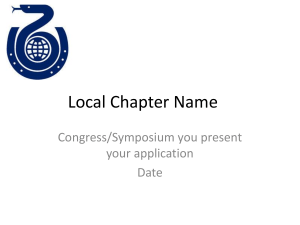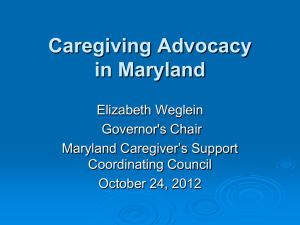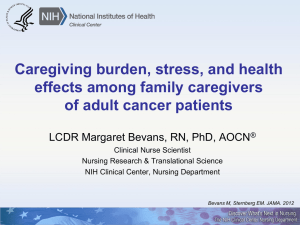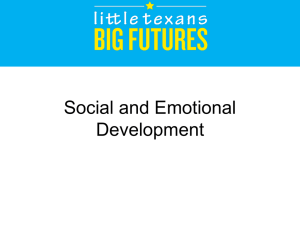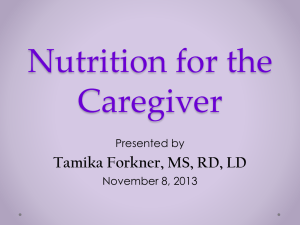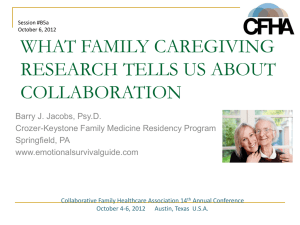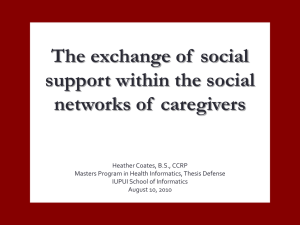Hui Ying Ng - Methodological Challenges
advertisement
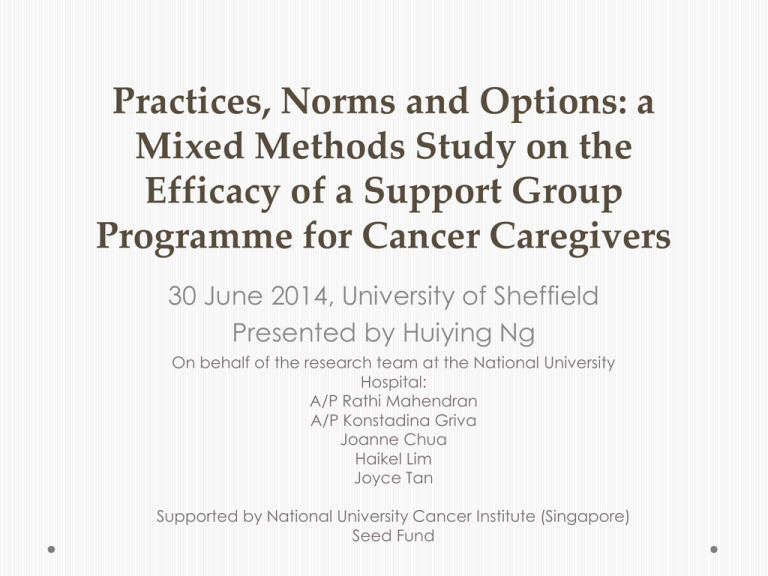
Practices, Norms and Options: a Mixed Methods Study on the Efficacy of a Support Group Programme for Cancer Caregivers 30 June 2014, University of Sheffield Presented by Huiying Ng On behalf of the research team at the National University Hospital: A/P Rathi Mahendran A/P Konstadina Griva Joanne Chua Haikel Lim Joyce Tan Supported by National University Cancer Institute (Singapore) Seed Fund Overview • Background: Conceptual Beginnings • Context: Caregiving in Singapore • Challenge #1: Finding a theoretical framework (and introduction to SDT) • Methodology: Mixed Methods • Challenges and Solutions Adopted • Preliminary Findings • Methodological Recommendations Fulfillment Prejudice Social Identity Theory Conflict Collective identity Discrimination Insufficient structure Options & information Self-realisation Lack of an “integrated and continuous social self” Individual identities Norms Options Habitus Caregiving in Singapore • “Family” / “informal” caregivers • Low public awareness of caregivers’ psychological support need • Filial piety and family obligation • Disinclination to speak about cancer Self-determination Theory Motivation Autonomy Basic Psychological Needs Competence Relatedness Research Aims 1. How a supportive social environment may assist caregivers in achieving better psychological resilience, namely through providing autonomy support, interpersonal involvement and a structured framework for caregiving 2. How these aspects of the social environment interact with caregiving motivations to result in psychological outcomes 3. The qualitative form that such a social environment would take. Methodology Quantitative Qualitative Construct Measure Semi-structured interview Caregiver Quality of Life and Burden Caregiver Quality of Life-Cancer (CQOLC) Pre-intervention •Challenges faced •Family support •Caregiving disruption to life goals •Expectations of group Perceived Stress Scale (PSS) Caregiver Stress Hospital Anxiety and Depression Scale (HADS) Basic Psychological Needs Basic Psychological Needs Scale (BPNS) Perceived Competence Perceived Competence Scale (PCS) Perceived Autonomy Support Healthcare Climate Questionnaire (HCCQ) Perceived Relatedness Interpersonal Support Evaluation List (ISEL) Post-intervention •“What did you like or not like about the support group?” •Improvements •Met expectations? Quantitative Measures Construct Measure Reliability in previous samples Caregiver Quality of Life and Burden Caregiver Quality of LifeCancer (CQOLC) = .91 (Weitzner et al., 1999) Perceived Stress Scale (PSS) = .91 (Sheldon Cohen & Janicki-Deverts, 2012) Caregiver Stress Hospital Anxiety and Depression Scale (HADS) = .76 (Lok & Bishop, 1999) Basic Psychological Needs Basic Psychological Needs Scale (BPNS) = .79 to .87 (Ilardi et al., 1993; Kasser, Davey, & Ryan, 1992) Perceived Competence Perceived Competence Scale (PCS) = .95; Williams et al., 1996) Perceived Autonomy Support Healthcare Climate Questionnaire (HCCQ) = 0.80 (Williams, Freedman, & Deci, 1998) Perceived Relatedness Interpersonal Support Evaluation List (ISEL) = .81 (Scrignaro, Barni, & Magrin, 2011) Thematic Analysis Theoretical understanding of motivations, basic psychological needs Review of dataset: Inductive coding of themes and codes Fitting codes to theoretical framework Challenges and Solutions Qualitative: 1. Citing family ties as a reason for caregiving—not explicitly value-laden 2. Citing filial obligation—which is value-laden—how do we decide if someone is falling on the maladaptive side of a social norm? 3. Choice to use semantic meanings rather than latent meanings Mixed methods: 1. People mention different motivations all across the duration of the interview. How do we rank people by their level of motivation? 2. Goals: goal alignment, goal conflict, reprioritization, shifting goals, goals are unclear. Can we code these into analyzable categories? 3. How to relate personal goals to desires and motivation? 1 Code Definition (Ng et al., 2012) Example Intrinsic motivation Motivation due to the inherent enjoyment derived from the behavior itself. A facet of autonomous self-regulation. “I give care because I care about my care recipient” Integrated regulation Motivation to engage in behaviors which are in congruence with other central personal goals and values. A facet of autonomous selfregulation. “I give care out of filial piety.” Identified regulation Motivation reflecting the personal value of the behavior’s outcomes. A facet of “It makes me happy to see her clean” autonomous self-regulation Introjected Regulation Motivation reflecting internal pressures such as contingent self-worth, guilt, shame, and need for external approval. A facet of controlled regulation. “If I don’t give care, I would feel ashamed of myself.” External Regulation Motivation to comply with external pressures or rewards. A type of controlled regulation. “I give care because it’s expected of me.” Ng, J. Y. Y., Ntoumanis, N., Thogersen-Ntoumani, C., Deci, E. L., Ryan, R. M., Duda, J. L., & Williams, G. C. (2012). SelfDetermination Theory Applied to Health Contexts: A Meta-Analysis. Perspectives on Psychological Science, 7(4), 325–340. doi:10.1177/1745691612447309 Preliminary Findings • Preliminary analysis focuses on motivations and cultural issues Change in Positive Adaptation 26 25.5 • Does the group relate to better wellbeing? Positive o Yes: group provides caregivers Adaptation with expert information, Scale reminders of self-care tips, role models and downward social comparison, and an understanding that they are not alone. o Yes; quantitatively, the group increased positive adaptation scores. 25 24.5 Control 24 Intervention 23.5 23 22.5 Pre Post Time Preliminary Findings • How do our qualitative and quantitative findings complement each other? o Qualitative findings suggest that caregivers’ motivations for caregiving may influence the benefits they draw from the group, as well as their support needs o Motivations for caregiving fell under two broad categories: externally regulated motivations (FP or family obligations) and intrinsic motivation (pleasure of caring). o Quantitatively, more internal motivations correlated with more positive outcomes and fewer negative outcomes Pre-intervention Post-intervention Motivations for caregiving r = .856 r = -.799 + Basic Psychological Needs - Financial Concerns + Basic Psychological Needs r = .910 + Autonomy r = .812 + Relatedness r = .969 - Stress r = -.917 Further steps • Socio-cultural norms may interact with individual motivations to influence caregiver distress, the support they receive from the group, and improvements in outcomes. • Norms? Caregiver post-intervention outcomes may relate to their initial levels of motivation • Further analysis: o o o o o Qualitative benefits of the support group Relation of qualitative aspects with basic psychological needs (BPN) Relation of qualitative aspects with caregiver outcomes Relation of qualitative and BPN with caregiver outcomes Interaction of qualitative aspects and motivations to affect outcomes Thank you for listening! Questions?
